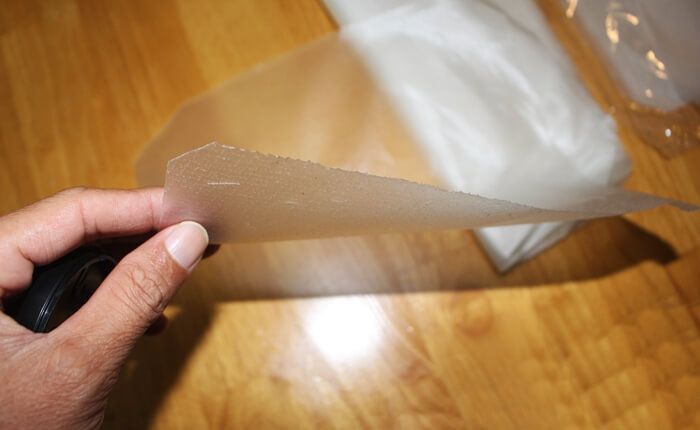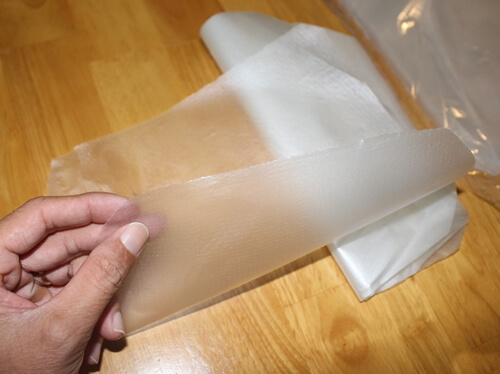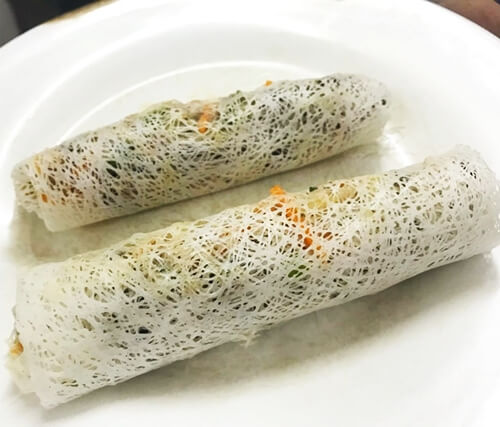Rice paper wrappers or thin rice papers are so familiar in the meals in Vietnam. The people use them to wrap spring rolls, eat pancakes with vegetables, and make pork rolls.
The basic wrappers are made by hand from 100% rice and a little bit of salt. However, nowadays, many factories can produce them by machine and add a little tapioca flour. Each thin wrapper can roll from 4 – 6 rolls, depending on large or small rolls.
The thin rice papers are soft and flexible enough to wrap spring rolls without moistening or dipping them in water. Typically, this kind of wrapper absorbs very little oil, which is better for health.
How to choose a rice paper wrapper
When choosing a wrapper, you should prioritize choosing a rice paper wrapper with moderate thickness.
You do not choose the hard type because it can be crushed and difficult to roll, while the flexible wrapper will not keep the crispiness when fried. Meanwhile, if the rice paper is too thick, it will make the spring rolls hard and chewy.
Currently, there are popular types of rice paper wrappers:
1. Basic thin rice paper wrappers (Banh Trang Gao) have a cloudy-white color and are often used to roll fried spring rolls in North Vietnam. Also, they are easy to break and melt in the mouth.
2. Thread rice paper (Banh Trang Re): When frying it, it is very crispy and melts in the mouth. Often, used for fried shrimp rolls. You will see clear threads on the rice paper.
Choosing the correct wrapper types for spring or shrimp rolls is necessary, depending on what you want to wrap.
It should be noted that when you use to wrap food processed to eat directly, thin rice paper wrappers (Banh Trang Gao) are a good choice. Vietnamese people never select thread rice paper wrappers to roll pancakes, raw vegetables with meat, etc.
Another requirement in choosing this product is that the wrapper is not broken, torn, moldy, or dusty. When it has a strange smell or sour taste, you need to choose another one.
How to make this rice paper wrapper
There are two types that you can see:
- Wet or fresh rice paper wrappers are made to serve the same day. This type is often used for Pho rolls and cooked shrimp rolls with meat to eat immediately.
- Dried rice paper wrappers are sun-dried or dried by machine for extended storage. Depending on the place of production and the way of packaging, dry rice paper can be kept for 1-3 months. Many enterprises in Vietnam use modern production lines to produce this type.
Vietnamdrive will show you how to make wet rice paper wrappers.
You need to prepare all the materials and tools below:
- A round pot with a diameter of 40 – 60 cm.
- A clean cloth 10 – 15 cm larger than the pot diameter.
- A thin stick or knife to pick up the rice paper.
- A round big spoon to pick it out.
- Rice flour is about 250 grams. It more or less depends on how many you want to make.
Starting:
- Take nearly half a pot of water.
- Spread the cloth to the top of the pot. Keep it as straight as possible to make rice paper easier.
- Close the lid, and put the pot on the stove to bring it to a boil.
- Mix the powder with water in a small bowl until it becomes light liquid enough to spread evenly over the fabric. Usually, 250 grams of rice flour are mixed with 700-800 ml of water. Add a little salt to give the wrappers a rich flavor.
Making:
- Scoop a spoonful of rice flour and pour evenly over the surface of the cloth over the pot of boiling water. Take the spoon to spread it evenly, and move the spoon into a circle evenly to create a nice thin circle on the surface.
- Cover the pot with the lid, and wait 2 minutes for the ingredients to be steamed.
- Open the lid of the pot and use a thin stick or a knife to gently remove the rice paper from the pot surface. You’ve got a wet rice paper wrapper.
The step of taking off rice paper after steaming from the surface of the cloth on the pot is considered the most difficult step to do. So you need to practice a few times, possibly ruining a few.
Here is a video about making thick rice paper, and black sesame is added to create more flavor. Make the thick one the same with a thin rice paper wrapper.
Frequently Asked Questions
Where can I buy rice paper wrappers?
These wrappers are popular for daily food, so you can easily see them at many Vietnamese supermarkets or local markets, even in small retail shops. But, it is better to get good ones at the supermarkets when they preserve them better.
Do rice paper wrappers get gluten-free?
Rice paper wrappers are gluten-free as the product group of rice, soybeans, corn, potatoes, and mung beans. However, you need to pay attention to a few modern wrappers that can add other ingredients besides rice and salt, so those ingredients can contain gluten if they are.
Is the rice wrappers healthy?
It is because the main materials of the rice paper wrap come from rice, which contains many special nutrients such as magnesium, vitamin B6, iron, calcium, protein, and potassium, which can be good for your health. Despite that, you may find the rice paper rolls can be fried, so the oil from this frying process can influence your body.
Are rice paper wrappers different from rice paper?
Yes and no. Why? They are not different because both kinds are from rice flour, nearly the same method. But, they are different because rice paper wrappers are much thinner, which are used to wrap the food. Meanwhile, rice paper often refers to thicker ones, which can be grilled before eating.


